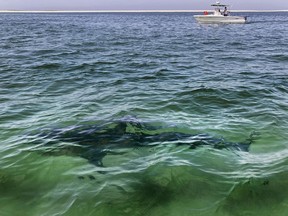
A new study has found that improved fisheries management and conservation measures are turning the tide on shark and ray population declines in the northwestern Atlantic Ocean.
The results show how well-enforced governance coupled with science-based fishing limits can help aquatic life recover, concluded the study published last week in the journal Proceedings of the National Academy of Sciences.
Sign up to receive the daily top stories from the National Post, a division of Postmedia Network Inc.
Thanks for signing up!
A welcome email is on its way. If you don't see it, please check your junk folder.
The next issue of NP Posted will soon be in your inbox.
Lead author Nathan Pacoureau from Simon Fraser University in British Columbia said declines have been halted in three species, and six species are rebuilding their numbers, including great white, hammerhead and tiger sharks. The study focused on 26 threatened species, whose ranges stretch from Newfoundland and Labrador as far south as Uruguay. There are about 1,200 shark and ray species worldwide.
“We try to take a look at the few bright spots we have and to highlight how conservation and management is actually working when implemented,” he said.
He attributed the population increases to the implementation of a 1993 U.S. fishery management plan for Atlantic Ocean sharks, developed in response to the increased demand for shark meat and fins. Those regulations include catch reporting requirements, quotas and catch prohibitions for some species, he said.
Before the 1990s, the study said, commercial and recreational fishers were encouraged to fish for sharks, resulting in severe depletion of some large coastal sharks.
Shark and ray populations have plummeted by as much as 71 per cent globally over the past 50 years with nearly one-third of the animals threatened with extinction.
However, Pacoureau said, stronger enforcement of vessel permits along with a quota on how many species can be harvested helped numbers rebound.
Co-author John Carlson said regulation of catch limits, bans on harvesting certain species and enforcement of the rules will help populations rebound.
The 1993 plan, which has been updated over the years, is a testament to a partnership between industry, enforcement and scientists, said Carlson, who is a fish biologist at the U.S. National Oceanic and Atmospheric Administration.
“It’s a combination,” he said. “The industry has worked with us … we’ve got better science and better data, which has allowed us to produce more accurate assessments.”
Different species of sharks vary in their life histories and timing of reproduction, making it difficult to manage populations, he noted.
“Some reach sexual maturity at two years. Some reach sexual maturity at 20 years. So obviously you would want to manage those a little differently based on what the science is telling us.”
The dusky shark, for example, reaches sexual maturity only at age 20 and gives birth once every two or three years, Carlson said. So dusky sharks have seen a stabilization in population but have yet to recover, he added.
While shark populations have seen an increase along the northwest Atlantic, they still face dangers of overfishing in global waters, said the study.
“We are now in a critical decade where the future of fisheries and the world’s oceans will be determined not only by the extension of protected areas but also by our ability to effectively assess and manage fisheries sustainably in the remainder of the ocean,” it said.
Carlson said international engagement and co-operation is the best way to help sharks and rays.
“There’s species that we share across borders. Sharks don’t know borders, they swim across it.”
Pacoureau said a number of countries have commitments toward biodiversity and agreements on fisheries and catches.
“The problem is they sign these treaties, but they don’t really implement it,” he said. “The first thing is countries should live up to their commitments and actually do what they say.”
This report by The Canadian Press was first published Feb. 1, 2023.


